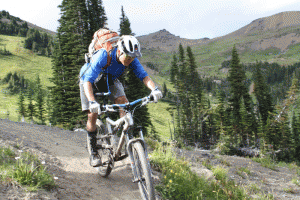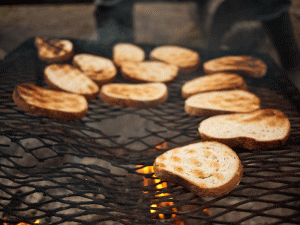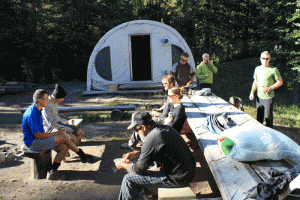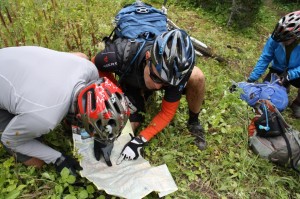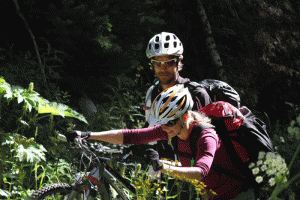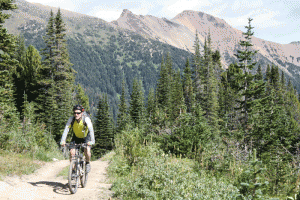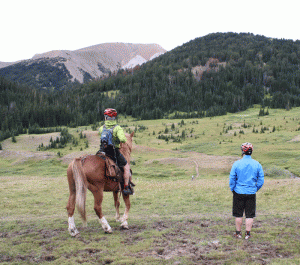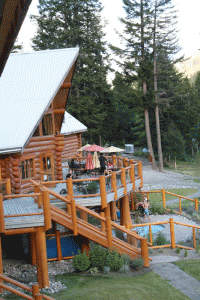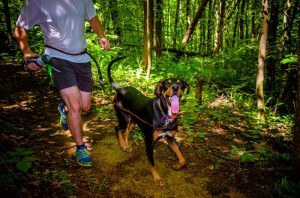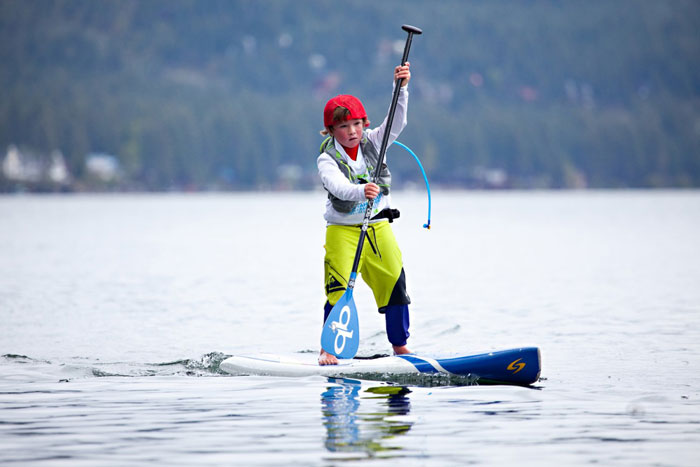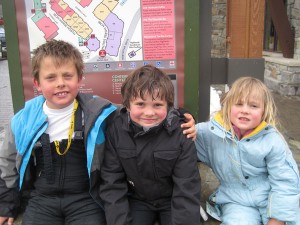- Inner Space: What We All Seek in the Great Outdoors - 06/28/2024
- Editor’s Note #132 // The Hurt Cycle - 02/15/2024
- Editor’s Note // Blessed are the frequency holders - 11/20/2023
Lessons learned on a backcountry mountain biking adventure in Canada
By Matt Niswonger
I was five hours north of Vancouver, in a mountain range known as the Chilcotins. It was dawn.
I opened my eyes and stared at the tent ceiling. Suddenly wide-awake, I realized there might be something wrong with my body. Every muscle was on fire.Then I remembered the brutal elevation gain of the previous day. I had to laugh as I crawled out of my sleeping bag like a decrepit old man. An occasional mountain biker from Santa Cruz, the steep climbs of the previous day were beyond anything I had ever done, and now I was paying the price.
Multiple cups of coffee were a step in the right direction, but I still felt like I had been in a bar fight. Looking around, I took stock of the dozen or so crazy Canadians with whom I was sharing this backcountry adventure. All were strong riders. A former national champion MTB racer, a sponsored professional rider, strong amateurs who bike and ski all year round; I was out of my league.
The Canadians didn’t seem any worse for the wear. In fact, they seemed downright perky. Not surprised given their fitness,their behavior still struck me as a bit over the top. As I observed them laughing, telling stories and doing yoga, I said to myself, “What is wrong with these people? Are they superhuman or just total sandbagging liars?”
Though grueling, I had to admit the previous day might have been a personal breakthrough. I couldn’t say for sure, however. The experience was still too raw, too immediate to process clearly. Certainly I had gotten my butt kicked—that much was undeniable. Replaying the tape in my head, I flashed on wide-open country with miles of single track snaking off in every direction. Also, I pictured the perfect rolling trails, eighteen inches wide for mile after mile. There were giant alpine valleys, glowing with neon wildflowers. And yes, I couldn’t forget about the rocky sections of hill climbing that almost pushed me to the breaking point. More than anything else, my first day in the Chilcotins was huge physically and mentally.
Snapping out of my stupor, I saw that the Canadians were gathering around maps and planning out the day’s journey over coffee. All we really had to accomplish was a return trip to the Tyax Lodge, our starting and ending point for this epic. By the shortest route, the lodge was “only” four hours away, down a beautiful valley. I had assumed this “easy” route would be the automatic choice. Not so.
It dawned on me that these crazy Canucks were planning a truly diabolical day of elevation gain and loss. Jonathan, a buyer for a chain of Canadian outdoor retailers, was proposing a route. Yep, sure enough he was using words like “interesting”, and “worthy.” Anyone who has been around Canadians or Brits will recognize this classic sandbagger language: “The first two hours of such and such route is ‘worthy’ and it would access some very ‘interesting’ terrain. I consider this option to be quite ‘full-value.’” Sandbagger translation: death march.
Jayson, a prominent businessman in Squamish/Whistler circles, was tracing his finger along contour lines that conveged into an almost solid line on the map, indicating very steep terrain. “Doing this ‘piece’ would put us into such and such valley, which would make the whole thing ‘unique.’” Sandbagger translation: super death march.
Inserting myself into the conversation, I had to put an end to this classic game of Canadian one-upmanship before our route back to the Tyax Resort turned into a ten-hour campaign of misery. “It might be ‘neat’ to stuff rocks in our packs and use ice axes to climb gullies all day with our bikes dragging behind us on ten-foot leashes…” I quipped. The point of my comment was to hint at the fact that it was quite silly to flog our selves with a brutal day of elevation gain and loss, when a perfectly reasonable and quite direct way home was more logical.
My joke would have played well in back in Santa Cruz, but in the Chilcotins it was met with stony silence and one or two polite laughs. The entire group just sort of stared at me with a look on their faces that could have been interpreted as, “Who brought the lame American?”
I smiled right back at them defiantly because I knew my quip was funny. That sort of sarcasm would’ve at least registered some hearty laughter back in California. However, I had to admit these Canucks were a bit mysterious to me. Apparently, most of them sincerely wanted to take the long way home, even if it meant pushing a 25-30 pound bike up a cliff for hours at a time.
After more discussion it became clear that we would not be taking the easy way back to the lodge, and I steeled myself for a long, brutal ride. After breakfast we packed our belongings, got our bikes ready, and prepared for a 10 a.m. departure.
From our camp at Spruce Lake, we were heading right back the way we came, up to Windy Pass. For the next two hours we gained over a thousand feet of elevation, and we spent most of that time pushing our bikes up goat trails. Dripping with sweat, slobbering, talking to myself, I was on the verge of taking a vow of celibacy and joining a monastery. Surely I had committed grave sins in a former life to deserve such suffering. Certain sections of the trail were so steep I could barely make progress. I was humbled and at the same time impressed with these Canucks. They were physically tough and impressively able to maintain a positive attitude.
Climbing, the forest of subalpine firgave way to alpine scrub and scree, and our objective came into view. High above, a wall of mountains split into a saddle that promised spectacular views and entry into a system of valleys that the Canadians were keen to explore. Referring to these valleys in hushed tones imbued with reverence, I could tell they were anticipating something remarkable.
We crested the pass, and ate lunch. Moving on before the cold settled into our bones, we traversed a series of ridges and retained most of our elevation. Some sections required our full concentration, but nothing was dangerous. The trail was consistently about two feet wide. Ahead was mountain topography that suggested the Swiss Alps in scale and drama, but the overall aesthetics could only be described as otherworldly. The color green played itself out in a thousand personalities, from day-glow electric to dark and mysterious. I blinked and two hours passed by.
For a while that day – September 2nd, 2012 – time stopped being linear. We just sort of floated down from the throneroom of the Chilcotins, charged with the power of our surroundings. At one with our bikes, the single track flowed beneath us formiles. Completely taken with the scenery, I couldn’t wipe the smile off my face.
We crested a rise and I was startled to see a large thoroughbred charging toward us at a gallop. With a full Western saddle and no rider, this horse was obviously an escapee. Collectively springing into action, Jonathan radioed the lodge; group leader Brent Martin took off down the trail to find the horseless equestrian, andWhistler businessman Jay Symons tried to slow down the panicked animal. Symons, apparently a cowboy in a former life, calmed the horse, mounted it, and took off down the trail to return the animal to its owner. The entire sequence of events had a certain surreal quality to it, like we had somehow fallen into a movie and were following a script.
Having accomplished our good deed for the day, we headed for the Tyax Lodge. My spirits were dampened a little by another uphill push, but I kept my attitude in check.
The last of the uphill conquered, we finished our ride via a highly enjoyable trailcalled Molly Dog. Fast and exciting, it was a great way to end the day’s journey. After seven hours and some of the best mountain biking of my life, we rolled into the Tyax Lodge at 5:30 p.m.
The Tyax Lodge is a luxury hotel and restaurant that serves heli-skiers in the winter, and bikers, equestrians, and sightseers in the summer and fall months. Located on Tyaughton Lake at the foot of the Chilcotins, it was the perfect way to pamper ourselves after a mammoth ride.
That night at dinner we celebrated two epic days of pedaling. The food was delicious, the wine was flowing, and I feltprivileged to be a part of this group of Canadian mountain bikers. Trip leaders Dale Douglas and Brent Martin gave speeches to the group, and there was a bit of emotion in their voices as they thanked everyone for coming. It became clear that this trip was many years in the making, and the fulfillment of an ambitious dream for both men.
Brent and Dale were old-school mountain bikers from the North Shore of Vancouver. Having made the pilgrimage to the South Chilcotins in the late eighties and early nineties, Dale was one of the early pioneers. Blown away by the potential of the place, he shared it with Brent. Soon after, they hatched an audacious plan. Dale, a pilot by trade, and Brent, the CEO of a sunglasses company, set the wheels in motion for an MTB guiding business in one of the most beautiful mountain ranges in Canada.
By using Dehavilland Beaver floatplanesto resupply encampments strung out in the wilderness, true backcountry MTB became a reality in the Chilcotins. Working with the established model of hut-to-hut ski touring operations in the European Alps, their efforts have resulted in a world-class endurance MTB destination, attracting clientele from Europe and America. Dubbed Tyax Adventures, Dale runs the business on a day-to-day basis, while Brent functions as an ambassador, co-marketing the brand with his company, Ryders Eyewear.
Eating dinner with leaders and luminaries in the Canadian outdoor industry, I was inspired by their love for authentic wilderness travel via mountain bike. Judging by the high-powered people at my table, I concluded that word would be spreading very quickly about what was happening in the Chilcotins. Everyone in that room had pushed themselves pretty hard to experience the power of backcountry riding in a magic place, and all seemed stoked to carry the message.
Personally, I vowed to return. This place had changed me. Skeptical at first, I hadlearned to appreciate the meaning of the phrase “full value.”


